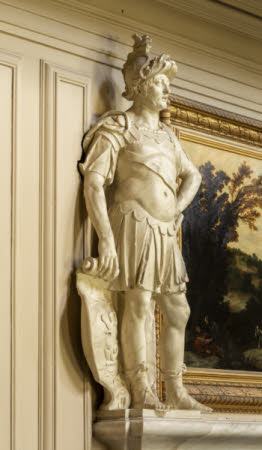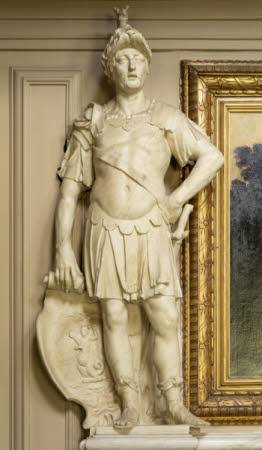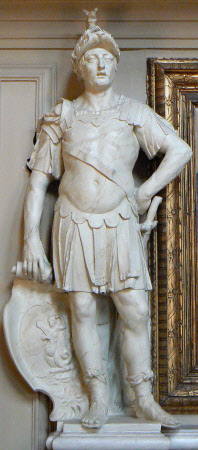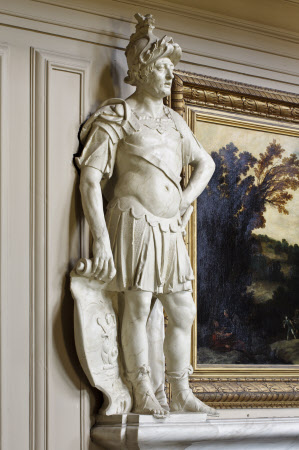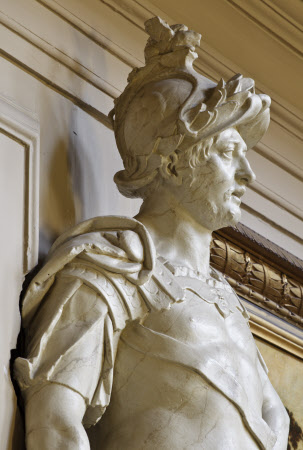Mars, God of War
attributed to Peter Besnier (fl.1643, d.1687-93)
Category
Art / Sculpture
Date
1637 - 1639
Materials
Plaster of paris
Measurements
1650 mm (H); 700 mm (W); 270 mm (D)
Place of origin
London
Order this imageCollection
Ham House, Surrey
NT 1139652.1
Summary
Painted Plaster; Mars, god of war; attributed to Peter Besnier (died 1687/88); 1637-39. A standing figure in plaster of Mars, god of war, dressed in armour and holding a shield, attributed to Peter Besnier, positioned on one side of the chimneypiece in the Great Hall of Ham House. Companion to a figure of Minerva, goddess of wisdom and the arts, but also war. The two figures, sometimes said to depict William Murray and his wife Catherine Bruce, are today mounted on the two ends of the marble chimneypiece in the Great Hall of Ham House.
Full description
A near life-size standing figure of Mars, the god of war, a pair to the matching figure of Minerva, also a goddess of war, but also wisdom and the arts. The two figures today stand upon the outside sections of the large marble chimneypiece that dominates the Great Hall of Ham House. Dressed in all’antica armour, Mars wears a close-hugging corselet, square at the collar and with a grotesque mask at the centre of the neck, his shoulders protected with leather straps. He wears a skirt, with leather strips (pteruges), elaborate sandals and a helmet embellished with a laurel wreath and surmounted by a crouching dragon, part of which is now broken off. With his right hand Mars supports an auricular shield, in the centre of which, in relief, is a mermaid upon the sea, holding a mirror, the device of the Murray family. His left hand rests on his hip just by his sword, which is a type of weapon known as a falchion, with a hilt in the form of an eagle head. His companion Minerva is likewise dressed as a martial figure. The two near life-size plaster figures of Mars and Minerva at Ham House are likely to have been commissioned in c. 1637-39 by Catherine Bruce, Mrs William Murray, and her husband William Murray. They first appear in an inventory however only in 1728, presumably because until then they had been regarded as an element of a chimneypiece. It has been proposed that they might originally have formed part of a chimneypiece in the Great Dining Room (today’s Round Gallery), surmounting the Salomonic columns that now flank the chimneypiece in the North Drawing Room. With their shields prominently displaying the devices of the Bruce and Murray families, the figures of Mars and Minerva are nevertheless well suited for display in the entrance area of a house. It has often been suggested that the Mars is a portrait of William Murray, later Earl of Dysart and that the Minerva depicts his wife, Catherine Bruce. The two figures have long been admired as vigorous and freshly-conceived examples of British sculpture from before the Civil War. They were previously attributed to Francesco Fanelli (1577-c.1661?), a Florentine sculptor by birth, who worked for some years in Genoa, before he travelled to England to work for King Charles I. He is first recorded in England in 1632 and remained in the country until at least 1643, when he may have left as a result of the worsening royalist position in the Civil War. It is not known if Fanelli returned to Britain after the Restoration, but his son Giovanni Battista (1605–1672) was certainly operating a workshop in London by 1663, when he was granted a Royal Warrant by Charles II. Although Fanelli did make larger sculpture, he appears in Britain to have principally engaged in the making of small bronze figures, which have a liveliness and strong sense of movement that is not to be seen in these larger figures. Recently Charles Avery has attributed the figures, and much of the rest of the sculpture at Ham House, to Peter Besnier, another immigrant sculptor who worked for Charles I in the 1630s. Of French, probably Huguenot origin, Besnier may have arrived in the 1630s in London, where his brother Isaac was already resident. Both men may have worked as assistants to Hubert Le Sueur (c. 1580-1658), also a court sculptor to Charles I, who made a number of large bronze sculptures during his years in Britain. But Isaac Besnier also worked as an independent sculptor,so is for instance documented as having carved all the stonework figures for the monument to George Villiers, 1st Duke of Buckingham in Westminster Abbey, completed in 1634, the bronze elements of which were made by Le Sueur. Other monuments have been recently attributed by Avery to Isaac Besnier, including the monument to Sir Robert Aiton in Westminster Abbey, of c. 1638, in which the bronze bust of the subject set within an oval is flanked by large standing figures of Apollo and Minerva, similar in conception to the Ham House Mars and Minerva. The Ham House figures likewise have parallels with the two female figures supporting the coat-of-arms at the summit of the Buckingham monument. All these works display a similar repertoire of late Mannerist forms, with somewhat elongated proportions, and smallish, oval faces. One small but telling feature that links the Ham House figures to those in Westminster Abbey is the way in which the figures on the Buckingham monument and the Ham House Minerva hold their shields, running their hands and wrists through an opening in the auricular cartouches of the shields and resting their hands below. However, the figures by Isaac Besnier in Westminster Abbey are stiffer and clumsier than the Ham House figures, which seem more likely to be by Peter Besnier, to whom the magnificent bronze bust of Catherine Bruce at Ham House (NT 1139887) is now generally attributed, and who clearly had a much greater awareness of modern sculptural movements, especially the Roman baroque. Peter Besnier is first recorded in 1643, when he was appointed Sculptor to King Charles I, tasked with taking over from his brother Isaac, who perhaps had moved back to France amidst the chaos of the Civil War, the specific responsibility of caring for the ‘Moulds, Statues and Modells’ in the royal collections (For Besnier, see Adam White, ‘A Biographical Dictionary of London Tomb Sculptors c. 1560-c. 1660’, The Walpole Society, Vol. 61 (1999), pp. 1-162, pp. 11-12; idem., ‘A Biographical Dictionary… Addenda and Corrigenda’, The Walpole Society, Vol. 71 (2009), pp. 325-55, pp. 329-30). Besnier was not able to take up his post because of the Civil War, whilst in the following years his known devotion to the Royalist cause meant he fell into ‘great poverty and want’, as he explained when, after the restoration of King Charles II, he successfully petitioned for reinstatement as Sculptor to the King. Peter Besnier died in 1687/88; his son was Thomas Besnier, who was highly praised by George Vertue. In addition to the most important pieces in the house, the Mars and Minerva and the portrait bust of Catherine Bruce, the Besnier family is likely to have made most of the sculptures supplied to Ham House between the 1630s and the 1670s, including the long series of lead busts now arranged along the garden walls and the north front of the house. It would have been natural for these patrons, first the Murrays and subsequently their daughter Elizabeth and her husband the Duke of Lauderdale, so closely bound to the fortunes of the reigning monarch both before the Civil War and following the Restoration, to have chosen to commission work from sculptors who worked principally for the Stuart court. Jeremy Warren January 2022
Provenance
Probably commissioned c. 1637-39 by Catherine Bruce, Mrs William Murray, and her husband William Murray; Ham House inventory, 1728, Great Hall, ‘a picture over ye Chimney & Two Statues’; Ham House inventory, 1844, Entrance Hall, ‘Two plaister figures on chimney piece’; thence by descent, until acquired in 1948 by HM Government when Sir Lyonel, 4th Bt (1854 – 1952) and Sir Cecil Tollemache, 5th Bt (1886 – 1969) presented Ham House to the National Trust. Entrusted to the care of the Victoria & Albert Museum until 1990, when returned to the care of the National Trust, to which ownership was transferred in 2002.
Makers and roles
attributed to Peter Besnier (fl.1643, d.1687-93), sculptor Francesco Fanelli (b.1577), plasterer
References
Thornton and Tomlin 1980 Peter Thornton, and Maurice Tomlin. “The Furnishing and Decoration of Ham House.” Furniture History, The Journal of The Furniture History Society Vol.XVI, 1980, p. 177, fig. 32. Avery 2013: Charles Avery, ‘Seventeenth-century Sculpture at Ham House’ in Christopher Rowell, ed., Ham House. 400 Years of History, New Haven/London 2013, pp. 158-77., pp. 160-62, fig. 145.
